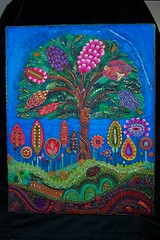Eventually these links will point to dedicated posts and I’ll have more detailed reviews of each, but I thought I would throw this up now. This is the current state of my spindle collection.
Suspended spindles, Top Whorl:
Tabachek Deluxe in Purpleheart and Hickory, 40.0g/1.41oz.
Tabachek Delux in Pear and Imbuya, 47.0g/1.66oz
Houndesign Laceweight in Pau Amarillo
Ask the Bellwether starter spindles The Bellwether Spinde page
Zebisis Designs in Labrodorite and Black Rosewood, 24.8g/.87oz. 1 5/8”/40mm whorl, 10 1/2”/26.5cm shaft. Etsy listing
Spanish Peacock Top Whorl in Australian Cypress and hard Maple, 2 1/8” whorl, 8” shaft. Etsy listing
Spanish Peacock Top Whorl Snowflake in Holly and Cocobolo, 3” rim 10” shaft. Etsy listing
Grizzly Mountain Arts Mini Rim-Weighted in Thuya Burl and Cocobolo, 31g/1.1oz. 2” diameter whorl and 7 3/4” shaft. Etsy listing
Bosworth Maxi in Quarter-sawn Red Oak and birch, 49g/1.75oz. 9 1/4” shaft. Maxi Spindle Page
Suspended spindles, Turkish:
Jenkins Turkish Standard in Beeswing Nara (and maple?), 2oz. Turkish Standard page
Threads Through Time Medium Turkish in Tulipwood and Bloodwood, 1.6oz. 6 4” whorl, 3/4” length. Etsy listing
Jenkins Kuchulu in Marblewood and Kingwood (#167), 10 g.. Turkish Kuchulu page
Suspended spindles, other:
Forrester Akha
Supported Spindles:
Tabachek Tibetan in Ash
Takhli from Celeigh wool
Spindlemaker wishlist:
Spindles by Sourkraut – New Zealand silversmith and word turner. She started making spindles fairly recently and has the most beautiful organic shapes.
I love the whorl shape on this one. And I want to get a Silver Inlay spindle. Or one of the gem-flower ones, or . . .
Bosworth Spindles – Incredible workhorses with smooth and lasting spin. I have a maxi but want more sizes. It is probably not possible to have too many of these ones.
Jenkins – Still want a Meadowlark/Jay and possible a Aegean.
IST Crafts – Ian from the Isle of Wight makes beautiful spindles. Sharon at Golden Willow in Regina stocks them too. I’m particularly curious about his teeny Turkish spindles, although I hear great things about his other ones as well.
Gripping Yarn – Lisa is the queen of supported spindles. She has developed her own hybrid spindle, the Rose, which is a blend of Russian and French styles. I would love to get one of hers some day.
Golding – Ah, the Golding Ringspindles. These are sweet. Now, I’m not saying I need a Swan Lake or anything, but a Tsunami or Solid would be perfectly reasonable. Someday I’ll see a Golding Spinning Wheel in person and that will be a sight to behold.
Jeri Brock Woodworks – the scroll work on these is fantastic. Someday, for sure.
Trindleman – these are just nifty and have a very different feel. He’s now making them with interchangeable beads, too, so you can fit different weights on the same shaft. I spun one at Olds and it was really nice.
Autumn Hollow Farms – this is purely for the beautiful combination of wood and stone. I like the inlay and I hear they spin well.
Wood and stone are my first loves, but there are some really interesting spindles made out of other materials. Top of my wishlist are:
Petlyn Alpaca – an Australian maker that has metal spindles. They run a little heavier than what I see most commonly but I think I like it that way. I love the Paisley designs, and dyed fibre can look beautiful through the spokes.
Wildcraft Resin Spindles – again, the clear resin lets you watch the fibre cop build up. Beautiful. I especially love the ones with flowers and leaves embedded in them.
Tilt-a-whorl – These are really skillfully up-cycled spindles. I like the rainbow ones, and he’s also started making some teensy ones that I really want to try.
Know that the Spindle Candy group on Ravelry is almost entirely responsible for this addiction (check out the flickr spinoff). And Spindle Lore is to blame for the next section.
Spindle type wishlist:
Phang – rhymes more with song than fang, but still looks entirely like a vampire stake. Gripping Yarn version, Phang in action.
Navajo Spindles – crazy different from other supported spindles. Maybe should wait until I have a bigger apartment, but these spindles are for making bulkier yarn. The shaft is 3 feet. Bristlecone Artisan Heirlooms has some lovely ones. Video of a Navajo Spindle in action. Longer video about Clara Sherman, a Navajo weaver
Bulgarian, French — more to come soon.
